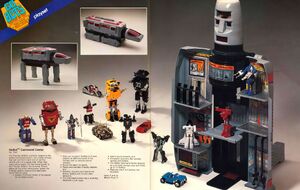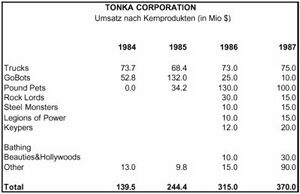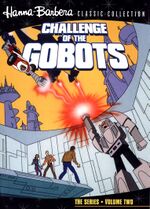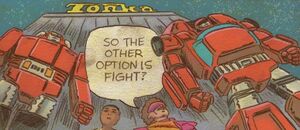Tonka
Tonka is an American toy company best known for producing tough metal trucks and construction vehicles which are ideal for sandbox playing and ramming into parents' legs without breaking. They created the GoBots brand in 1983 as a way of marketing Machine Robo toys in North America. Since 1991 the company has been owned by Hasbro, with hilarious results.
History[edit | edit source]
Tonka had been founded in 1946 as Mound Metalcraft, initially making toy vehicles as a side-line to their main business of making garden implements, but soon they were making toys full-time. In 1955 the company was renamed Tonka, inspired by the Dakota Sioux word "tanka", meaning 'big' or 'strong', and diversified into other areas.
GoBots[edit | edit source]
In 1983 Tonka struck a deal with Bandai to licence Machine Robo figures in the United States and Canada. Bandai had tried themselves to do so under the Machine Men name but as their American operation was small at the time they struggled with promotion and distribution, which Tonka could easily improve. It is almost certain that Tonka's move was inspired by Hasbro's purchase of Takara's Diaclone and Microchange for what would become Transformers, though no documented proof exists and it is unlikely to ever be officially confirmed. Tonka's initial plan for what they called GoBots relied more on speed than detail; 28 extant Machine Robo figures were rushed to stores in late 1983 mounted on blister cards with individual names and little else - such was the lack of forward planning the figures didn't even have proper factions, being designated as "Friendly" or "Enemy" GoBots.
Nevertheless the figures - retailing at $2.99 apiece - were an immediate hit, and were soon followed by a swathe of further releases. Larger Machine Robo figures became the Super GoBots and while Tonka themselves didn't have the expertise to make any further figures they were able to design plastic playsets and action toys designed to interact with the toys for the range, while a memorable series of TV commercials with the jingle "Mighty Robots, Mighty Vehicles" pushed sales even higher. Tonka also happily licensed the GoBots branding to anyone willing to pay for it, resulting in an explosion of peripheral merchandise.
Transformers hit American stores in 1984 and were a hit themselves; their more detailed backstory, greater variety and complexity of figures and overall higher-quality feel soon began to make even bigger waves than GoBots had done. In response to the planned Transformers animated mini-series from Marvel Productions, Tonka commissioned one of their own from Hanna-Barbera, with the first episode of the five-part mini-series premiering six weeks after the first episode of Transformers "More Than Meets the Eye" opener. The GoBots series was a ratings hit, leading to the 60-episode syndicated series Challenge of the GoBots, but the cartoon did little to help shake GoBots' tag as the more juvenile of the lines.
1985 saw the demand for all things transforming robot explode, with every toy company in America and beyond trying to get in on the action by either making or licensing figures - Select had Convertors, Ertl had Pow-R-Tron, Buddy-L had Robotron, Mattel had Powerbots, Remco had Zybots, Lanard had Ro-Bots, Village Toys had Convert-A-Bots, Intex had Moto-Bot and so on. Many of these lines had very poor quality but sold well - if not as well as Transformers and GoBots. Tonka's line was in fact doing so well they exhausted the backlog of moulds available from Bandai, even commissioning the Japanese company to make them more. However they struggled to translate the high sales of the small figures to other parts of the range.
Inevitably bust followed boom. 1986 saw most of the fly-by-night lines wiped out and GoBots began to lose ground in the contracting market. Challenge of the GoBots finished its' first run on December 13, 1985 and was not commissioned for a second season; a plan to gazump Hasbro once again by getting a feature film out ahead of Transformers the Movie was a pyrrhic victory - GoBots: Battle of the Rock Lords arrived in theatres eight months ahead of its' competitor but was a bomb at the box office and what critical notice it drew was mixed. To make up a third series of figures Tonka had to resort to commissioning more figures from Bandai and even using rejected Machine Robo prototypes but to no avail; GoBots sales slumped by 80% in 1986 and the line was wound down - Tonka instead concentrating on their newer hit Pound Puppies.
Rock Lords[edit | edit source]
1986 had also seen Tonka launch Rock Lords, also based on licenced Machine Robo figures that turned into rocks. While the Rock Lords characters had appeared in GoBots: Battle of the Rock Lords and featured a couple of times in the short-lived GoBots Magazine the toyline was marketed separately from GoBots. The line had a reasonable first year but then, as the number of available figures and the novelty factor dwindled, slumped the next year and was cancelled.
Takeover[edit | edit source]
Despite GoBots and Rock Lords both being cancelled, Tonka were still raking it in from their other lines and took over rival Kenner-Parker in 1987. However they had to take out large loans to fund the $555m buyout and when the late-1980s recession hit Tonka struggled to service the debt and in 1991 were bought out by Hasbro.
GoBots ownership[edit | edit source]
All the various trademarks Tonka had devised for the series, such as the GoBots and Rock Lords brands and the various trademarks associated with them, were thus the property of Hasbro. At the time the original Transformers series had just finished and Hasbro had little use for another transforming toyline, though they would strengthen the trademark by naming a Transformers: Generation 2 figure Gobots in 1993 and an assortment named Go-Bots in 1995, while in 2002 a range of pre-school figures named Transformers: Go-Bots was issued by Hasbro's Playskool imprint.
However the vast majority of the physical toys belonged to Bandai, who had come a long way since 1983 and was now a major competitor to Hasbro on the American market, notably with Power Rangers - making the slim theoretical chance of any reuse of the GoBots figures all but impossible. For some time there was considerable fan speculation as to who owned what around the GoBots brand, with much talk that Challenge of the GoBots was being kept out of circulation as Bandai had some claim to it. However this was resolved to some degree when the Warner Archive Collection released the entire series across three DVD sets from 2011 to 2015. A further show of Hasbro's confidence in their ownership of GoBots came in 2018, when they allowed IDW Publishing to produce a five-issue comic mini-series based on the property. However on the toy front "new" GoBots have entirely been represented by coy homages in the Transformers line.
As Transformers has delivered a multi-million cinema franchise Hasbro have little use for GoBots beyond the odd nostalgia niche; Bandai for their part have no need for a transforming robot line while Power Rangers remains a perennial, and their Machine Robo Mugenbine line has shifted into a more construction-toy based ethos. For their part Ashi Productions feel they have a strong enough claim on the likenesses of the figures to licence classic 1980s Machine Robo characters to Action Toys.
Relationship with Bandai[edit | edit source]
Whereas Takara imported Transformers back to Japan as a replacement for the Diaclone and Microman lines that formed the American line's basis, Bandai did not do the same for GoBots, instead continuing with Machine Robo until the line ended in 1988, outlasting GoBots by a good year or two. The reasons for this are broadly unknown but can be guessed at with moderate confidence.
- Firstly, it would appear that Machine Robo was doing better at the time than the Takara lines, with the Machine Robo Series celebrating an impressive 13 million units sold by 1985, so there was less need to parachute something in to revive its' fortunes.
- Secondly, the GoBots brand possibly had limited appeal to Bandai. While the rumour that an episode of Challenge of the GoBots was dubbed for a test audience and went down badly is unverified and probably apocryphal, and while it's a weeb fallacy to assume that every Japanese cartoon of the period looked like Zeta Gundam, it is hard to deny the simple Hanna-Barbera animation would likely have not appealed to Japanese audiences of the time. Without a cartoon that could be imported with minimal tweaking there was little else going for the GoBots brand.
- Thirdly, while the Japanese version of Transformers did make inroads into the market and was almost certainly a huge factor in the commissioning of the Machine Robo: Revenge of Cronos cartoon to counter, in Japan at the time Bandai were flat-out bigger than Takara. Even by the mid-1980s the likes of Gundam, Super Sentai and Kamen Rider were established perennials, and Bandai had the financial might to weather the competition without doing anything drastic. As such there was again little need for them to import a Transformers clone.
While this lack of a strong partnership has occasionally been cited as a reason for GoBots failing where Transformers didn't that theory doesn't really stand up to much scrutiny. Due to Transformers using a backlog of extant Takara designs, including numerous ones that weren't released until the switch to the Transformers brand, Hasbro and Takara don't seem to have started cooperating on the design front until around 1986/1987 (depending on how you count the animation-first process of the Transformers: The Movie cast) - by which point GoBots was already on the way out, a victim as much of a contracting Western market for robot toys as anything else.
On top of which there are several incidents which show a degree of cooperation existed between the companies that was comparable to that of Hasbro and Takara at the time.
- Numerous moulds were either created by Bandai exclusively for the Western market - such as the "MRT Series", the third series of Super GoBots and the Dread Launchers. Curiously TV Land occasionally featured spreads of such GoBots toys even though they were never issued in Japan, with the line's Western sister being no secret of Japanese readers.
- Similarly, Bandai also let Tonka go nuts on various rejected prototypes for the Machine Robo Series and Devil Invader Series, which made up the bulk of the final year of regular GoBots.
- There is some evidence that Bandai 'pitched' recolours of extant moulds to Tonka, with partial success.
- The agreement seems to have included some small amount of reciprocation, with Bandai issuing the Tonka-designed Command Center and Zod in their non-American markets.
- Rock Lords was developed in what appears to be an equal partnership, with Bandai overtly credited on the Western packaging.
Toys designed by Tonka[edit | edit source]
Catalogs[edit | edit source]
Each year Tonka issued a catalogue of their wares. It was not intended for public consumption, but as promotion for the company's toys to retailers and the like. GoBots featured in the 1984, 1985 and 1986 editions, while Rock Lords appeared in the 1986 and 1987 editions.
Fiction[edit | edit source]
Go-Bots comic[edit | edit source]
Tonka have revolutionised Earth with the Go-Bots, shape-shifting robots that have fulfilled numerous functions across society - transportation, military hardware, law enforcement, motor racing and even space exploration. However, a growing number are going rogue and rebelling against their human masters.Issue 1 However, Scooter remains loyal to A.J. Foster while Turbo also refuses to turn on his human friend Matt Hunter. The four meet up during the Go-Bot uprising and head towards the Tonka factory looking for answers after shaking off a pair of murderous Hans-Cuff police Go-Bots. When they arrive they meet a technician who gives a brutal assessment of humanity's chances against the Go-Bots, saying the problem is far beyond any firmware and that the Go-Bots have become intelligent enough to judge humanity - and have found them wanting. He recommends they run and hide before departing on the still-loyal Spoons. Issue 2
Tonka's creations went on to take over the world, at a terrible cost to humanity.








